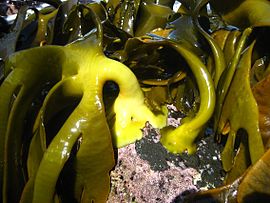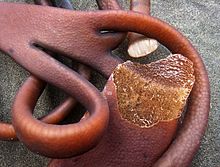- Durvillaea antarctica
-
Durvillaea antarctica 
Durvillaea antarctica stipes on Second Bay, Otago, New Zealand Scientific classification Kingdom: Chromalveolata Phylum: Heterokontophyta Class: Phaeophyceae Order: Fucales Family: Durvillaeaceae Genus: Durvillaea Species: antarctica Binomial name Durvillaea antarctica
(Chamisso) HariotDurvillaea antarctica is a large, robust bull kelp species and the dominant seaweed in southern New Zealand and Chile. D. antarctica has a circumpolar distribution between the latitudes of 29°S (in Chile) and 55°S (on Macquarie Island).[1] It is found on exposed shores, especially in the northern parts of its range, and attaches itself with a strong holdfast. D. antarctica, an alga, does not have air bladders, but floats due to a unique honeycomb structure within the alga's blades, which also helps the kelp avoid being damaged by the strong waves.
Contents
Morphology
The blades of Durvillaea antarctica are green to golden brown with a leathery texture. The species is characterised by the honeycomb structure of the blade, which gives it strength and buoyancy, and is unique among seaweeds.[2] This novel structure is thought to be responsible for the wide distribution of this genus, as the kelp is able to float when its holdfast fails. It may be able to colonise other coastlines in this manner.[3]
The holdfast of D. antarctica is large and is very difficult to remove. D. antarctica has to resist forces equivalent to 1100 km/h on land.[3][clarification needed] The holdfast failing is usually the result of worms and molluscs which feed on the tissue because of the sheltered habitat it creates.[4] It is also common for its host rock to be broken off without the holdfast losing its grip, with this contributing significantly to erosion in some areas.[1] Recruitment rates of this species is very low, therefore the ecological impact of harvesting this species is too great.[4]
Life cycle
Durvillaea antarctica reproduces sexually by producing egg and sperm that are released into the water. Eggs and sperm are produced on specific sites of the frond. A large individual can produce 100 million eggs in twelve hours (Bradstock, 1989). The season when reproduction occurs varies with location.
Chilean culture
Use in cuisine
In Chilean Cuisine, the Durvillaea antarctica (Quechua: cochayuyo : Cocha: sea, and yuyo: weed) stem and holdfast, known as hulpe is used for different recipes, like salads and stews.
Expression
The expression remojar el cochayuyo (lit. to soak the cochayuyo) is used in Chilean Spanish to refer to the sexual act.[5] The expression derives from the fact that this algae, that is harvested along Chile's coast, is preserved by being sun-dried and to prepare it then in a dish it needs to be softened up by being soaked in water.
Taxonomy
The species was first described in 1822,[6] as Fucus antarcticus, and revised in 1892 as Durvillaea antarctica.[7] The Latin derived epithet refers to antarctic.[8]
References
- ^ a b Smith, J.M.B. and Bayliss-Smith, T.P. (1998). Kelp-plucking: coastal erosion facilitated by bull-kelp Durvillaea antarctica at subantarctic Macquarie Island, Antarctic Science 10 (4), 431–438. doi:10.1017/S0954102098000522.
- ^ Maggy Wassilieff. Seaweed - Bull kelp’s honeycombed structure, Te Ara - the Encyclopedia of New Zealand, Ministry of Culture and Heritage. Updated 2 March 2009. Retrieved 9 March 2010.
- ^ a b Hurd, C (2003). The Living Reef. Nelson, New Zealand: Craig Potton Publishing.
- ^ a b Bradstock, M (1989). Between the Tides. New Zealand: David Bateman Limited.
- ^ La Ficha Pop, La Cuarta, 31 October 2006.
- ^ Choris, L. (1822). Voyage pittoresque autour du monde. Part I. pp. vi + 17, 12 plates. Paris
- ^ Hariot, P. (1892). Complément à la flore algologique de la Terre de Feu. Notarisia 7: 1427-1435.
- ^ Guiry, M.D.; Guiry, G.M. (2008). "'Durvillaea antarctica'". AlgaeBase. World-wide electronic publication, National University of Ireland, Galway. http://www.algaebase.org/search/species/detail/?species_id=11752.
External links
Categories:- Fucales
- Biota of Chile
- Flora of Gough Island
- Flora of New Zealand
- Flora of Macquarie Island
- Flora of Heard Island and McDonald Islands
- Flora of the Kerguelen Islands
- Flora of the Prince Edward Islands
Wikimedia Foundation. 2010.



